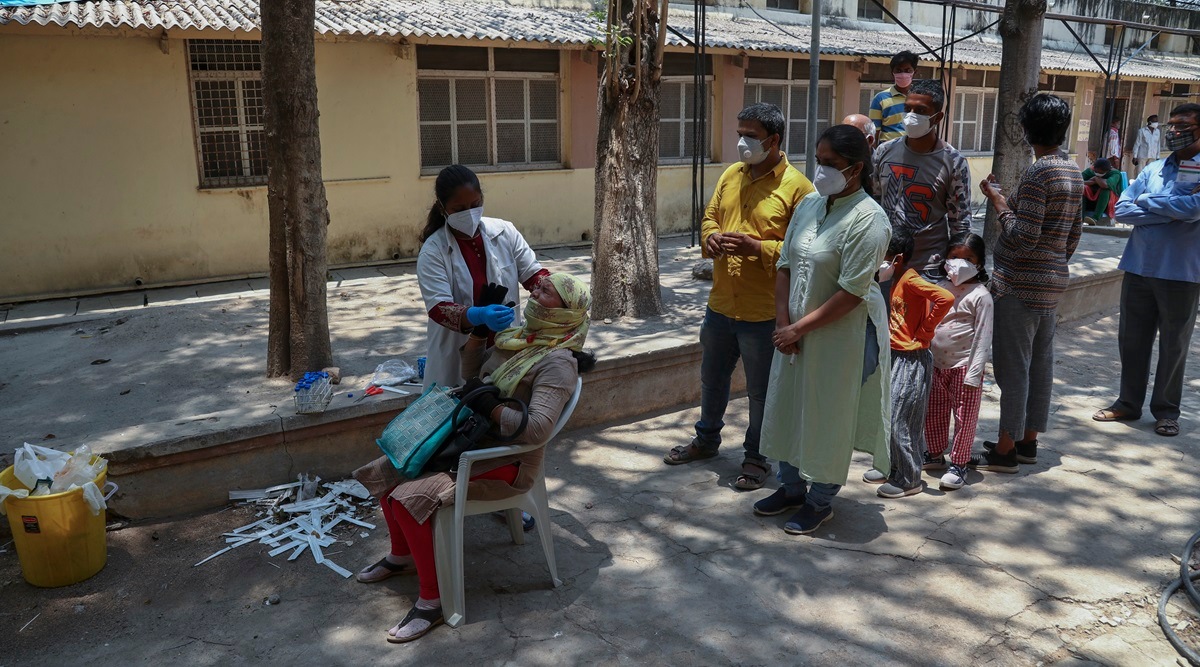 A health worker takes a nasal swab sample of a woman as others wait to test for Covid-19 in Hyderabad (AP)
A health worker takes a nasal swab sample of a woman as others wait to test for Covid-19 in Hyderabad (AP) The second Covid-19 wave in India hit us like a tsunami and disrupted us totally. It started very quietly, from the less exposed population clusters in some districts, and then spread rapidly to the rest of India. It is clearly a fast-spreading virus strain, but of unknown virulence. It definitely caught us napping but as resilient Indians, we are fighting it back with ferocity.
The history of pandemics suggests that waves will keep coming and going; we have to stay alert 24/7 to take the sting out of them. More than a 100 years ago, the Spanish flu ended World War-I, and during its second wave in India, more than 10 million people succumbed.
We need to accept our shortcomings and move with focus, positivity and clinical precision. It’s painful to see India being globally targeted when many other countries in the world have also faltered in their second waves. Western countries continue to report higher death rates in early waves of Covid-19 which is indeed painful given their high spending on public health, infrastructure, and reimbursement model of insurance. However, even as developed nations struggle with the second wave, we should not be looking outwards but inwards, and attempt to rewire our fragile, overburdened healthcare system to ensure we mitigate this crisis on a war footing.
We need to urgently stratify India in red zones of urgency which need medical attention, and save every life by ensuring that every case is assessed by a doctor. Based on that medical input, we need to triage or transfer or start home-based care without any delay, and ensure every case is connected to the medical healthcare provider digitally, 24/7. Cases which have a potential to deteriorate based on patient’s age, co-morbidities, persistent fever or cough or, most vitally, oxygen saturation dropping below 3% after a 6-minute walk, or below 93, must be shifted to a care facility, like the Mumbai war-room model.
In Mumbai, 24 war-rooms have people working in 12-hour shifts and stay connected with patients. In the early days, we had faced tremendous hardships and teething problems, but things seem to be settling down. For every case, we ensure that the patients and their family members isolate themselves, wear masks, get tested, and stay connected to their doctor. We also ensure that if they need medical care, they are shifted to a facility with beds, oxygen as well as medicines. Both the state and Central governments are working 24/7 to get essential supplies and oxygen across the length and breadth of the country, from urban metros to remote rural villages, and we need to work as ‘one India, one world’ in this hour of crisis.
At this time, more than 1.4 billion Indians need to be protected from Covid-19, and public health strategies have to be in place. All geographies which have a positivity rate above 10% must have strict restrictions in place, till the number comes down to below 5%. Once that target is achieved, we need to saturate the region with vaccination through the ‘ring vaccination’ method.
Apart from vaccines, which may take a few months to come in large supplies, masking is the strongest tool we have — we must double mask and keep distance from others. The contribution of aerosol exposure to the transmission of SARS-CoV-2 has been under scrutiny. Many global scientists have emphasised that infected individuals represent emission sources of aerosol, which is generated by routine activities, such as breathing, speaking, singing, coughing, sneezing — all of which might be capable of transmitting the disease.
SARS-CoV-2 is a typical respiratory RNA virus which spreads via aerosol generation. As with any infectious respiratory disease, an infected individual can release aerosols and droplets containing SARS-CoV-2 by coughing or sneezing. The transmission efficiency of SARS-CoV-2 has proved to be high, with reported reproductive numbers greater than that of the 2009 H1N1 influenza virus. SARS-CoV-2 have virus-containing aerosols and droplets that can lead to short-range airborne transmission (~ 6 ft). Such aerosols (<10-m diameter) and droplets (>10-m diameter) can promote infection through surface fomite deposition (still under scrutiny) or subsequent hand-to-mouth/nose/eye transfer.
Indian scientists need to study inhalation route to evaluate the infectious nature of SARS-CoV-2 on an urgent basis. Until scientific evidence emerges, it is useful for people to follow approaches that minimise their risk of infection by reducing their exposure levels and duration of exposure. The combined use of masks and physical distancing can be effective approaches for decreasing exposure to airborne forms of SARS-CoV-2.
We are resilient and strong, and will overcome this wave with grit and focus. Covid-appropriate behaviour, restrictions, and vaccination in Covid-dense geographies is the way forward.
The writer is a member of the Covid-19 Task Force, Maharashtra
- The Indian Express website has been rated GREEN for its credibility and trustworthiness by Newsguard, a global service that rates news sources for their journalistic standards.

